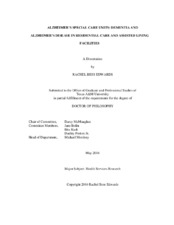| dc.description.abstract | Residential Care and Assisted Living Facilities (RC/AL) are rapidly becoming one of the most popular long-term supports and services (LTSS) care modalities, particularly for individuals living with Alzheimer’s disease or other forms of dementia. With the growing popularity of RC/ALs, the push toward these types of facilities over more expensive skilled nursing facilities, and the dramatically increasing prevalence of dementia, many Americans are turning to RC/ALs advertising Alzheimer’s Special Care Units (SCUs) for care of their loved ones. However, the absence of a federal definition for what constitutes an SCU, the varying state-by-state regulation of these units, and the scarcity of studies exploring the characteristics and effectiveness of SCUs provides little evidence for what actually goes on in an SCU and whether or not sufficient protections are in place for a particularly vulnerable population, cognitively impaired adults.
This study explored RC/AL SCUs at the facility level and at the individual or resident level. The first part of the study examined facility level characteristics of SCUs and the absence or presence of dementia care features across RC/ALs that have an SCU. The distribution of dementia care features demonstrates the variability of care in SCUs.
The second part of the study compared SCU residents to non-SCU residents across: demographics, health-related characteristics, facility characteristics, falls, ER use, and hospital stays (non-ER). Residents in SCUs have similar demographic characteristics as non-SCU residents; however, these two groups differ in health-related characteristics with residents living in SCUs reporting poorer overall health, much higher rates of incontinence and memory issues, and higher percentages of falls compared to non-SCU residents.
The third part of the study explored behavioral issues exhibited by RC/AL residents living in SCUs. The relationship between SCUs and four subgroups of behavioral issues (aggressive, physical, verbal, resistant to care) was explored, while controlling for demographics and health related characteristics. Behavioral issues are prevalent in SCUs.
The higher acuity of residents and the variability of care seen in this setting indicate that the current state of RC/AL SCUs may not be equipped to provide adequate care for individuals living with Alzheimer’s disease or other dementias. | en |


